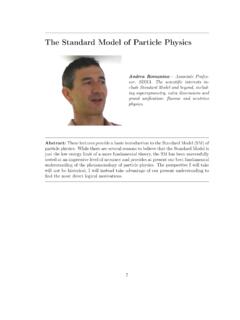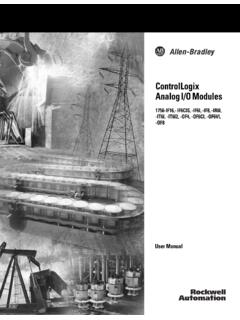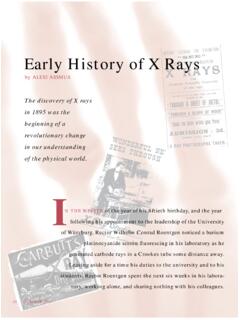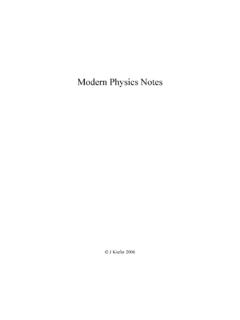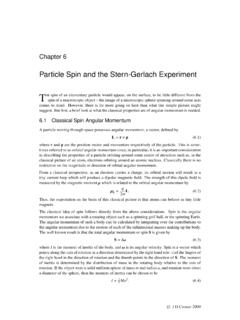Transcription of The Standard Model of Particle Physics
1 The Standard Model of Particle PhysicsAndrea Romanino Associate Profes-sor, SISSA. The scientific interests in-clude Standard Model and beyond, includ-ing supersymmetry, extra dimensions andgrand unification; flavour and :These lectures provide a basic introduction to the Standard Model (SM) ofparticle Physics . While there are several reasons to believe that the Standard Model isjust the low energy limit of a more fundamental theory, the SM has been successfullytested at an impressive level of accuracy and provides at present our best fundamentalunderstanding of the phenomenology of Particle Physics . The perspective I will takewill not be historical, I will instead take advantage of our present understanding tofind the most direct logical Standard Model of Particle PhysicsAndrea RomaninoSISSA/ISAS and INFN, I 34151 Trieste, Italy1 IntroductionThese lectures provide a basic introduction to the Standard Model (SM) of particlephysics. While there are several reasons to believe that the Standard Model is just thelow energy limit of a more fundamental theory, the SM has been successfully testedat an impressive level of accuracy and provides at present our best fundamentalunderstanding of the phenomenology of Particle Physics .
2 The perspective I will takewill not be historical, I will instead take advantage of our present understanding tofind the most direct logical motivations. As the level of the audience is quite diverse,I will summarize (in a concise, qualitative, and pragmatic way) the main theoreticalpreliminaries needed to make sense of what will follow. The hope is that a partof these lectures could be useful even to undergraduate students, that people whoare already familiar with QFT and gauge theories can also benefit from them, andpeople in between can have a first impact with the tools involved in a non qualitativetreatment. I will systematically use natural units, in whichc=~= 1:The SM Particle contentLet us start with the very basic main ingredients of the SM are shownin The particles involved are char-acterized by their spin, their mass, andthe quantum numbers (charges) determin-ing their interactions. The fermion content(spin = 1/2) is organized in three familieswith identical quantum numbers and differ-ent masses.
3 The heavier families are unsta-ble and decay into the lightest one, whichmakes up most of the ordinary matter (us).The four fermions in each family are distin-guished by their charges under strong andelectromagnetic interactions. Two of themare quarks, which are charged under thestrong interactions, and two are leptons,which are not. The two quarks have electromagnetic charges 2/3 ( up quarks) and-1/3 ( down quarks) respectively, and the two leptons have charges -1 (charged, or down leptons) and 0 (neutrinos, or up leptons), in units in which the electron8 Andrea RomaninoThe Standard Model of Particle Physicscharge is -1. The neutrinos are peculiar from two, probably theoretically related,points of view: they are neutral under both the strong and the electromagnetic in-teractions (they feel weak interactions, though) and they are at least six order ofmagnitudes lighter than all the other SM fermions. The masses of the SM fermionsspan a range going from the sub-eV neutrino masses to the1:7 102 GeVtop mass [1].
4 They exhibit quite a peculiar structure, with the masses of the different families be-ing hierarchically separated. Each fermion is associated to two so-called is conserved for massless fermions, in which case the chirality coincides withthe helicity. That is why the two possible chiralities are called left-handed and right-handed. From a theoretical point of view, chirality, by definition, distinguishes thetwo irreducible representations of the Lorentz group that can be used to describe spin1/2 fermions. Massive charged fermions are necessarily described by two componentsof different chiralities combined in what is called a Dirac spinor. As for neutrinos,only the left-handed chirality has been observed so far. This can be elegantly under-stood in terms of the quantum numbers of a possible right-handed component, butthe argument goes beyond the scope of these SM interactions are associated to the exchange of four vector bosons (spin =1). The photon mediates electromagnetic interactions, the gluon strong interactions,theZandWweak interactions.
5 The photon and the gluons are massless, while theZand theWare massive, which is the reason why weak interactions are weak atlow energy (they are suppressed by powers ofE=MZ;W, whereEis the energy ofthe process). Despite their weakness, they give rise to distinctive signatures becausethey violate parityP, charge conjugationC, their combinationCP, time-reversalT, and family number, which all are symmetries of the electromagnetic and strong1interactions. In particular, the decay of heavier into lighter families is due to description outlined above holds at relatively low energy and has long beenknown before the SM was invented. The SM description becomes necessary whenprocesses involving higher energies are considered. The transition from the low en-ergy effective regime and the SM regime takes place around the electroweak scalev 174 GeV. Above this scale, nature exhibits a higher degree of symmetry. Theelectromagnetic and weak interactions become indistinguishable and are unified inthe electroweak interaction.
6 The left-handed chirality components of up and downfermions also become indistinguishable and are unified in electroweak doublets. Theelectroweak scale is where such an electroweak symmetry breaks. Together withthe QCD and the Planck scale, it is one of the fundamental scales of nature knownat present. The mechanism through which the electroweak symmetry breaks is wellestablished, also experimentally, and is called spontaneous symmetry breaking. It isthrough such a mechanism that the fermions and the massive gauge bosons acquire1In the limit in which non-perturbative effects associated to the vacuum structure of QCD RomaninoThe Standard Model of Particle Physicsa mass proportional to the electroweak scale2. It is still not know, however, what isthe mechanism triggering the spontaneous breaking. The SM encodes the simplest(both from the theoretical and phenomenological consistency point of view) option:the Higgs mechanism [2]. Such a mechanism postulates the existence of a spin = 0field, the Higgs field.
7 Unlike all other fields, that require energy to be switched on,the Higgs field is on even in the ground state, where it permeates space-time. It isthrough their interactions with the Higgs field that the SM massive particles acquiretheir masses, proportional to the coupling to the Higgs. The identification of themechanism responsible for the electroweak symmetry breaking and the stability ofthe weak scale compared to the Planck scale are two central issues in today s particlephysics and are two of the most important missions of the order to go beyond the qualitative picture presented so far, I need to introducesome important theoretical tools, at least at a very basic level. The key tools aregauge theories and their spontaneous breaking. In Section2I will introduce gaugesymmetries, which allow to define the SM gauge sector in Section3. Spontaneousbreaking will be introduced in Section4, which allows to introduce the SM Higgsand Yukawa sectors in Section5. In Section6we will discuss the phenomenologicalimplications of the SM and mention the open Gauge (and global) transformationsThe SM is first of all a quantum field theory (QFT).
8 In QFT, particles are associatedto fields i(x),i= 1:::ndepending on the space-time coordinatesx= (x0;x1;x2;x3).We consider only fields with spins= 0;1=2;1(no gravity), the only ones needed forthe SM, and the only ones for which we know how to write a theoretically consistentQFT. Their dynamics is determined by an actionSwritten in terms of a LagrangiandensityL(x)(which I will simply call Lagrangian ) with dimension 4 in energy. TheSM Lagrangian is Lorentz-invariant and local, and it can be written as a sum ofmonomials in the values of the fields and their derivatives (up to two) in a givenspace-time point:S= d4xL(x);L(x) = kckOk(x):(1)In particular, the Lagrangian will contain: a term constant in the fields, which is notphysical as long as gravity is not taken into account; terms linear in the fields, whichcan be reabsorbed by a shift redefinition of the fields (x) (x) +c; terms bilinearin the fields, the free LagrangianLfree, which account for the free propagation ofthe fields and define their dimensions in energy (1 for the bosons and 3/2 for thefermions); terms with at least three fields, the interaction LagrangianLint, which2 Except possibly the neutrinos, whose masses are likely to be quadratic in the electroweak RomaninoThe Standard Model of Particle Physicsaccount for field interactions.
9 In a perturbative regime, the amplitude of any physicalprocess can be expressed as an expansion inLintrepresented (at a given order) by aset of Feynman diagrams. The simplest example of interacting QFT involves a singlereal, scalar field'(x)with LagrangianL= (@ )2=2 m2 2=2 4= dimension of the coefficientsckin eq. (1) is important, as it determinesthe properties of the corresponding interaction. Terms with negative dimension,c= 1= D,D >0, where is an energy scale, decouple at sufficiently low energyE,where their role is suppressed by(E= )D. They are called non-renormalizable . Only renormalizable terms with non-negative dimension of the coefficients are thereforerelevant at low enough energy. The presence of non-renormalizable terms becomesimportant at high energy, where they end up making the theory incalculable. Asthe amplitudes grow with(E= )D, in fact, higher order in perturbative expansionswill eventually become as important as the lower orders: the theory becomes nonperturbative.
10 This is signaled by the fact that the unitarity of the theory appearsto be violated at the perturbative level. Therefore, non-renormalizable terms can betolerated only in the context of an effective theory valid up to a certain energy scale( cutoff ) . At the scale , such terms should be accounted for by renormalizableinteractions, if the theory is to remain perturbative and calculable. Such theoreticalconsiderations played an important role in the development of the SM. The latter, aswe will see, was born from the need to express the non-renormalizable four-fermionFermi interaction accounting for weak interactions at low energy in terms of a renor-malizable us now come to the role of symmetries. We will be dealing with SU(N) andU(1) symmetry groups only. The generatorstof the group parametrize infinitesimaltransformationsu 1 i t, form a Lee algebra,[t1;t2] =it3,[t1;[t2;t3]]+[t2;[t3;t1]]+[t3;[t1;t 2]] = 0, and in the case of SU(N) are Hermitian traceless matrices. A standardchoice of SU(N) generators ista= a=2,a= 1;2;3, for the caseN= 2, where aare the Pauli matrices;tA= A=2,A= 1:::8, for the caseN= 3, where Aare theGell-Mann matrices;ti,i=i:::N2 1, with tr(titj) = ij=2, in the general case.
